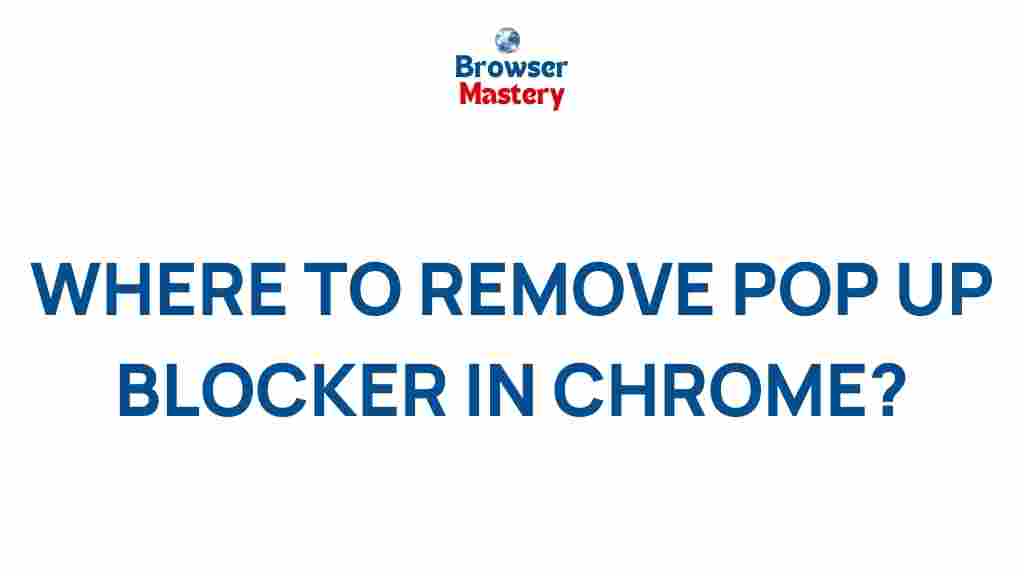Uncover the Hidden Settings: How to Disable Pop-Up Blocker in Chrome
When browsing the web, pop-ups can sometimes be a nuisance, but they are also necessary for some websites to function properly. If you’re using Chrome and have encountered a situation where pop-ups are being blocked when you need them, you may want to learn how to disable the pop-up blocker. In this guide, we’ll walk you through how to manage pop-up settings in Chrome, troubleshoot common issues, and make sure you only block the unwanted ones.
Why Pop-Ups are Blocked by Default in Chrome
Google Chrome has a built-in pop-up blocker to prevent annoying or malicious pop-up ads from appearing on websites. This feature is designed to enhance user experience by keeping your browsing clean and uninterrupted. However, some websites may rely on pop-ups for important features like login forms, video players, or promotional offers. Therefore, disabling the pop-up blocker in Chrome might be necessary to access all the content on certain websites.
How to Disable Pop-Up Blocker in Chrome
Follow these simple steps to disable the pop-up blocker on your Chrome browser. Whether you want to do this for a specific website or for all websites, this guide covers both options.
Step 1: Open Chrome Settings
Start by launching Chrome on your device. Then, follow these steps:
- Click on the three vertical dots located in the upper-right corner of the browser window to open the Chrome menu.
- Select Settings from the dropdown menu.
Step 2: Navigate to Privacy and Security
In the left sidebar of the settings page, click on Privacy and security. This section contains several important privacy settings, including site settings and content permissions.
Step 3: Go to Site Settings
Under the Privacy and security tab, scroll down to find the Site settings option. This is where you can adjust permissions for various website features, including pop-ups.
Step 4: Locate Pop-Ups and Redirects
Scroll down until you find the Content section. Click on the Pop-ups and redirects option. This will take you to a page where you can control how pop-ups behave on the websites you visit.
Step 5: Disable the Pop-Up Blocker
On the Pop-ups and redirects page, you will see a toggle switch that controls the blocking of pop-ups. To disable the pop-up blocker entirely:
- Click the toggle button to switch from Blocked to Allowed.
Once you’ve disabled the pop-up blocker, all pop-ups will be allowed on websites you visit. If you prefer to only allow pop-ups for specific sites, follow the next step.
Step 6: Allow Pop-Ups for Specific Websites
If you don’t want to disable the pop-up blocker globally, you can configure Chrome to allow pop-ups only for certain websites. This is particularly useful for websites where pop-ups are essential, like web-based email clients or online banking sites. To add a website to the exception list:
- Under the Allow section, click the Add button.
- Enter the URL of the website you wish to allow pop-ups for, then click Add.
Now, pop-ups will be allowed for the specified website, while other sites will still be blocked by default.
Troubleshooting: What to Do If Pop-Ups Still Aren’t Appearing
Sometimes, even after disabling the pop-up blocker, you may still encounter issues with pop-ups not appearing on a website. If this happens, try these troubleshooting steps:
1. Check for Browser Extensions
Some extensions in Chrome, such as ad blockers or privacy tools, may be interfering with pop-ups. Disable these extensions temporarily to see if pop-ups appear:
- Click the three dots in the upper-right corner and select More tools > Extensions.
- Disable each extension one at a time by clicking the toggle switch next to it.
- Reload the website and see if pop-ups are now working.
2. Clear Your Browser Cache
Sometimes, cached data can cause issues with pop-ups and other website elements. Try clearing your cache:
- Go to Settings > Privacy and security > Clear browsing data.
- Choose a time range (e.g., All time for a complete reset).
- Select Cached images and files and click Clear data.
After clearing your cache, reload the page to check if pop-ups are functioning correctly.
3. Update Your Browser
Outdated versions of Chrome may have bugs that affect pop-up behavior. Ensure your browser is up to date:
- Click the three dots in the upper-right corner of the browser.
- Select Help > About Google Chrome.
- Chrome will automatically check for updates and install them if necessary.
Once the update is complete, restart Chrome and test the pop-up functionality again.
4. Disable Browser Settings for Pop-Up Ads
In some cases, pop-ups may still be blocked by specific ad-blocking settings in Chrome. Make sure these settings are turned off:
- Go to Settings > Privacy and security > Site settings.
- Scroll down to the Ads section and ensure that the option for blocking ads is turned off.
Conclusion
While Chrome comes with a built-in pop-up blocker to keep your browsing experience smooth, there are times when you need to disable it, either for specific sites or entirely. By following the steps outlined in this guide, you can easily manage pop-up settings according to your needs. Always remember to troubleshoot if pop-ups still aren’t working after adjustments—checking for browser extensions, clearing the cache, or ensuring your browser is up to date can often resolve common issues.
If you encounter further issues with Chrome or want to explore additional features, you can visit Google Chrome Support for more help. For those looking for more privacy and security tips, check out this guide on protecting your privacy while browsing with Chrome.
This article is in the category Guides & Tutorials and created by BrowserMaster Team
